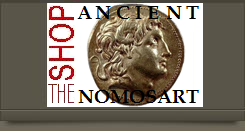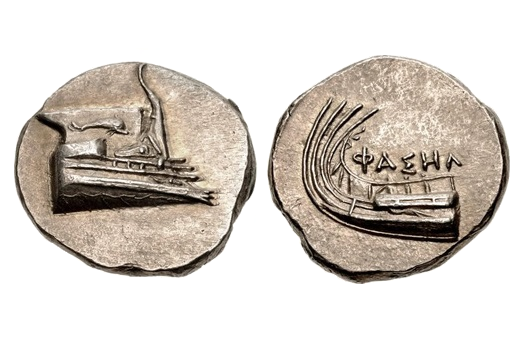
about ancient nomos
Ancient Nomos Art is a museum of galleries exhibiting ancient coins and ancient mint maps. The coin gallery displays the diverse art and history of hand-crafted ancient Greek, Roman, Byzantine, Persian and Medieval coinage. The ancient mints mapping gallery features Greek, Roman, Byzantine, Asia Minor and Medieval mint city regions and territories. Visitor's are welcome to explore, study and enjoy Ancient Nomos Art.

Greek, Phaselis – 350 BC
Lycia, Phaselis
From Ancient Galleries

Obverse: Prow of ship galley to the right, with fighting platform and dolphin image on deck; waves below.
Reverse: Stern of aphlaston galley to the left; Greek legend ΦAΣHΛ in the field above the ship.
LEGEND SYMBOLS
Obv: Prow of ship galley to the right with fighting platform on deck, decorated with swimming dolphin heading right; the raised apotropaic akrostolion is bent backwards, oar boxes below with central beam ending in upper ram; waves along ships hull. Rev: Stern of aphlaston galley to the left; legend ΦAΣHΛ in field above.
Ancient town of Phaselis was an important seaport located along the coast of southwest Asia Minor. The town was situated just below the massive promontory called the Bey Mountains in Lycia. It is thought that Phaselis was founded in the early seventh century BC by Greek settlers from the island of Rhodes. During the same period, these great Rhodian seafarers also founded the city of Gela, on the island of Sicily. This migration marked the great expansion of the ancient Greek culture, including extending their military power and political influences across the Mediterranean region. The small colony of Phaselis settlers was the one purely Greek city in Lycia and differed in language, culture, and alphabet from the adjacent cities of the region. The unique coinage of Phaselis is scarce and limited. Recent research on the Phaselis coinage has been chronologically outlined, studied and advanced through detailed die analysis by the Classical Numismatic Group (CNG), in Lancaster, PA. We are fortunate and grateful to provide an abbreviated citation of this work by CNG, without which our understanding of the above Phaselis stater would be greatly diminished. The complete citation by CNG on the Phaselis coinage may be viewed in the original publications noted below. According to CNG, “the coinage of Phaselis is among the earliest, if not the earliest, of all silver coinage struck in Asia Minor, beginning a few decades after the introduction of coinage in Lydia. Heipp-Tamer begins the coinage of Phaselis circa 550 BC with her Series 1.” The magnificent coin above is representative of a remarkable small group of specimens contributing to the scarce corpus of the coinage of Phaselis. This specimen is described as, “appearing to belong to Heipp-Tamer’s 6th series, known to her from only two coins, each from a different issue by virtue of the variation in their control marks, which she dated to the 4th century BC. The types of the coins are consistently prow right on the obverse and stern left on the reverse, with varying markings in the fields on both sides as well as on the prow’s fighting platform, likely denoting separate issues. In comparison to the similarly marked staters of the 3rd century that are marked with magistrates’ names (Heipp-Tamer Series 8, Emission 2), these staters are of more bold style both in type and epigraphy, with the exception of a few issues that have a monogram or no field markings. These latter issues have a more refined style, and longer ethnic; they appear to be the latest of these new issues, and might even be separated in time from the issues of bold style. If the varieties of control marks do, in fact, denote separate issues, we can add fourteen new issues to the two already identified by Heipp-Tamer. Nearly all of the coins exhibit little, if any, die wear, suggesting numerous brief issues. Their relative chronology is unknown, as there does not appear to be any die links. The various symbols in the fields and on the fighting platform of the prow are usual types for Greek coins: cicadas, dolphins, gorgoneions, grapes, owls, serpents, shells, stars, and tripods, as well as Pegasos and Nike. The three issues with Nike and tripod, as well as an issue with a wreath affixed to a pole on the deck of the prow, stand out, suggesting some sort of a victory reference. Whether any such victory would be a military or games-related event is unknown, as much of the historic details of Phaselis during this period are obscure.” Classical Numismatic Group (as cited in Triton XIX; CNR, Volume XXIII, Number 1, Winter, 1998; & Auction Catalog 99) Triton XIX
DOCUMENTATION
Value: Stater. Metal: AR Silver. Weight: 10.41 grams. Mint: Phaselis, Lycia. Date: Fourth Century BC.
Attribution: Heipp-Tamer Series Six, unlisted stater variety; CNG 100, 1526 (same dies); CNG 99, 286 (same dies). Photo Courtesy Classical Numismatic Group, Triton XIX, 261.
Legend, Documentation and Attribution
